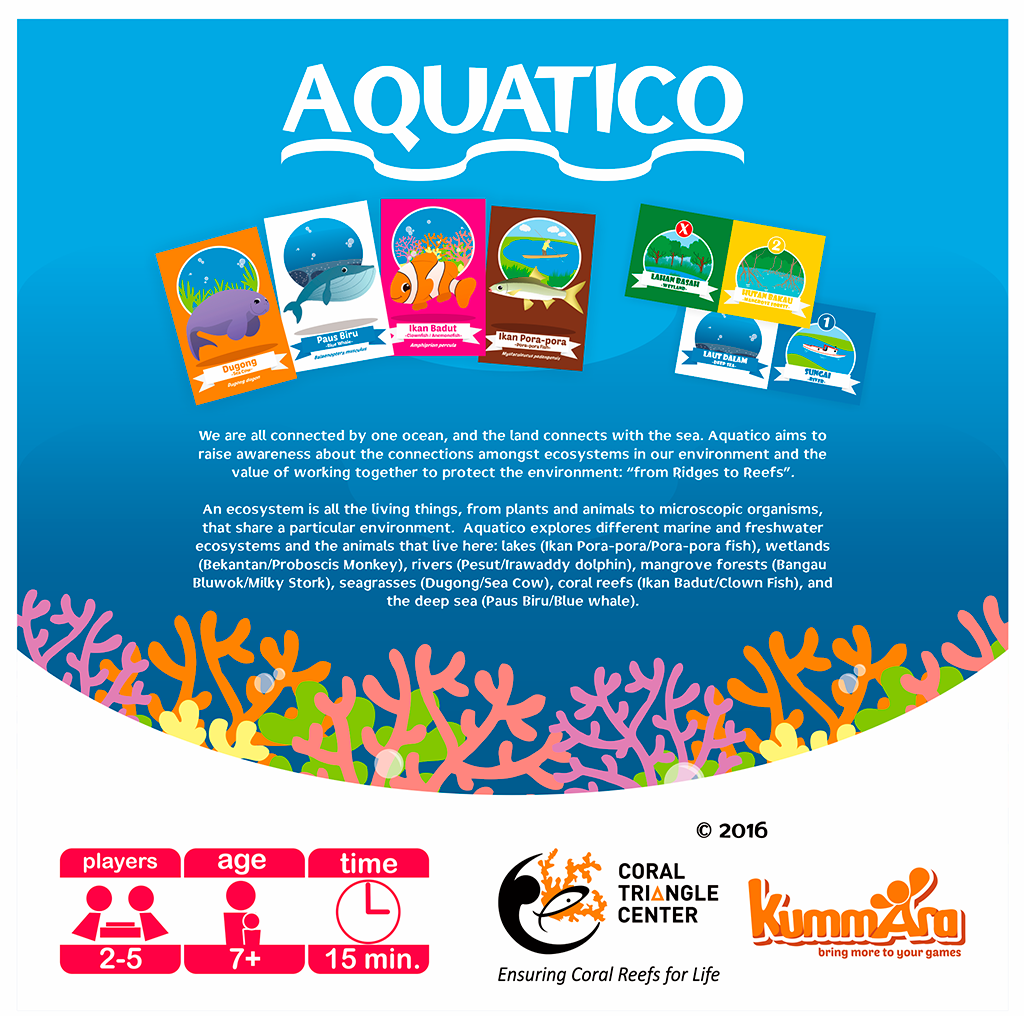 What is Aquatico?
What is Aquatico?
As part of the Coral Triangle Center’s (CTC) efforts to inspire more people to care for our marine environment, CTC launched its newest conservation-themed game “Aquatico” on March 27, 2016 at the Mertasari Beach Festival in Sanur, Bali.
Aquatico is a board game that highlights the role of healthy ecosystems in the conservation of iconic species such as the blue whale, dugong, and mola (oceanic sunfish).
The game will teach a very important function of such habitats and implies that the densities of species on coral reefs are a function of the presence of nearby bays containing mangroves and seagrass beds as nurseries ground. The degradation or loss of these habitats could have significant impacts on reef-fish stocks and other species
The game is being developed by CTC in collaboration with Kummara, an Indonesian game design and consultancy company with a vision to create “games for change.”
More About Science behind the Aquatico
What is an ecosystem?
An ecosystem is defined as “a spatially explicit unit of earth that includes all of the organisms [plants and animals], along with all the components of the abiotic [non-living] environment within its boundaries” (Likens, 1992, in Cury et al., 2003).
Ecosystem/Shallow Water Aquatic Environment
What are the most important ecosystems found in shallow coastal waters? The three most important shallow coastal ecosystems include
1) Coral Reefs,
2) Seagrass.
3) Mangrove Forests
Each with high levels of unique fauna and flora biodiversity. These three ecosystems play an imperative role and function in fostering interdependency and mutualistic symbioses between nature and human. In addition, they provide several important yet sensitive environmental services like sites for fishery resources and tourism.
Coral Reefs: function to prevent coastal abrasion and provide shelter as they neutralize currents and waves. In addition coral reefs serve as spawning and aggregation sites including nurseries for fish and other marine organisms.
Seagrass: is often considered an ecosystem engineer since it contributes to its own growth and habitat formation. The leaves slow down water-currents thus increasing sedimentation, while the seagrass roots and rhizomes stabilize the seabed. Seagrass, through its three-dimensional structure in the water column and high productivity resulting in large abundances, provides effective shelter for other organisms. Seagrass also provides coastal zones with a number of other ecosystem goods and services, including fishing grounds, wave protection, oxygen production, and protection against coastal erosion, fish spawning and aggregation sites, and toxin filtration.
Mangrove Forests: functions as land’s first defense against sea abrasion. In addition, mangroves provide nursery habitat for many wildlife species, including commercial fish and crustaceans, thus contributing to sustaining the local abundance of fish and shellfish populations.
Marine Protected Area for Saving Ecosystem
What is Marine Protected Areas (from Fernandes et al 2012)
Marine protected areas (MPAs) are tools that can be used in any approach to marine resource management. But some folks do tend to think of them as a management approach – even though they are not.
MPAs are not just no-take areas; they encompass a range of types of protection. A marine protected area is included in IUCN’s definition of protected area which is “A clearly defined geographical space, recognised, dedicated and managed, through legal or other effective means, to achieve the long-term conservation of nature with associated ecosystem services and cultural values.” (Dudley 2008). IUCN/WCPA (1994) in (Sale, Van Lavieren et al. 2010) explicitly defined MPA as a means to protect part or all of the enclosed environment. Protected areas are distinguished from other kinds of marine spatial zoning in that they have nature conservation as a primary rather than a secondary aim (World Commission on Protected Areas – Marine 2010). The category VI protected areas explicitly have the sustainable use of natural resources as a means to achieve nature conservation (Dudley 2008). In this way, then, any clearly defined, managed area that contributes to protection of natural resources in some way is a marine protected area.
Therefore, marine protected areas can be used to describe locally managed marine areas, multiple use marine parks, marine spatial zoning etc.



